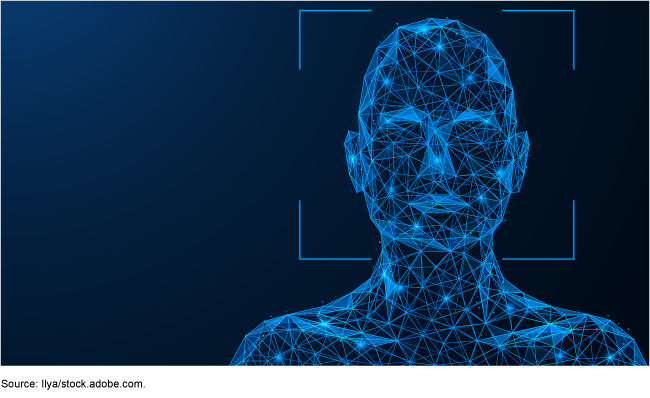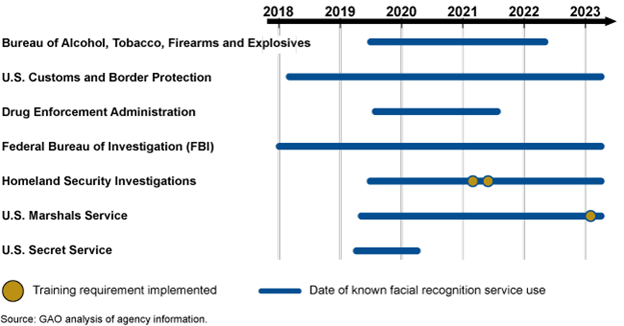Facial Recognition Technology: Federal Law Enforcement Agency Efforts Related to Civil Rights and Training
Fast Facts
We testified about our prior work on federal law enforcement's use of facial recognition technology. In 2023, we reviewed 7 agencies in the Departments of Homeland Security and Justice that had reported using the technology to support criminal investigations.
All 7 agencies initially used facial recognition services without requiring staff to take related training. Two agencies required it as of April 2023. Also, we reported that some agencies didn't have policies specific to facial recognition technology to help protect people's civil rights and civil liberties.
DHS and DOJ have taken some steps to address the issues identified in our report.

Highlights
What GAO Found
Seven law enforcement agencies within the Departments of Justice (DOJ) and Homeland Security (DHS), such as the Federal Bureau of Investigation and U.S. Secret Service, reported using facial recognition technology to support criminal investigations. Three of the seven agencies reported owning facial recognition technology. All seven reported using systems owned by other entities, such as state and local entities and nongovernment service providers.
In September 2023, GAO found that three of the seven agencies had policies or guidance specific to facial recognition technology that were intended to help protect civil rights and civil liberties. The other four agencies—three in DOJ and one in DHS—did not have such policies or guidance. We also found that DOJ had taken steps to issue a department-wide policy but had faced delays. After our September 2023 report, DHS finalized a department-wide policy, which includes topics such as limiting the use of the technology; protecting privacy, civil rights, and civil liberties; and testing and evaluation of the technology. DOJ also said it has developed an interim policy on facial recognition technology with topics such as the protection of civil rights and civil liberties, and training requirements. However, GAO did not have an opportunity to review and confirm that information.
The seven agencies reported using four nongovernment facial recognition services in total from October 2019 through March 2022 to support criminal investigations. All seven agencies had initially used these services without first requiring staff to take training on topics such as how facial recognition technology works, what photos are appropriate to use, and how to interpret results. GAO found that, cumulatively, agencies with available data reported conducting about 60,000 searches using facial recognition services when they did not have training requirements in place. Two of the seven agencies ultimately implemented training requirements as of April 2023. Of the remaining five agencies, two continued to use facial recognition services and three halted their use of the services as of April 2023.
Facial Recognition Services Use and Training for Selected Agencies, April 2023

Note: The figure shows when agencies used the four services covered by our review (services used from October 2019 through March 2022), and when, if at all, agencies implemented training requirements for facial recognition services. The figure provides use and training information as of April 2023. See figure 2 of the statement for more detail.
Why GAO Did This Study
Law enforcement agencies may use facial recognition technology to help solve crimes. For example, the technology can allow users to quickly search through billions of photos to help identify an unknown suspect in a crime scene photo. Civil rights and civil liberties advocates have cautioned that an overreliance on the technology in criminal investigations could lead to the arrest and prosecution of innocent people, or that its use at certain events (e.g., protests) could have a chilling effect on individuals' exercise of their First Amendment rights.
GAO was asked to testify before the United States Commission on Civil Rights on the use of facial recognition technology by DHS and DOJ. This statement discusses GAO's prior work examining the extent to which seven selected law enforcement agencies have (1) owned and used facial recognition technology, (2) developed policies to help protect civil rights and civil liberties related to its use, (3) required staff to take training prior to use, and (4) taken steps to address selected privacy requirements.
This statement is based on reports published from 2021 through 2023 related to federal law enforcement agencies' use of facial recognition technology. To conduct that prior work, GAO administered a survey questionnaire to 42 federal agencies that employ law enforcement officers regarding their use of the technology, including the seven agencies that are the focus of this statement. GAO also reviewed relevant documents and interviewed agency officials. GAO selected the seven agencies because they previously reported owning or using facial recognition technology systems.
Recommendations
In September 2023, GAO made ten recommendations to DHS and DOJ related to their use of facial recognition technology to support criminal investigations. GAO's recommendations focused on topics such as safeguards for civil rights, training, and privacy. DHS and DOJ concurred with the recommendations.
